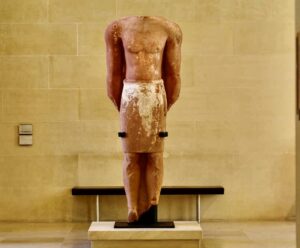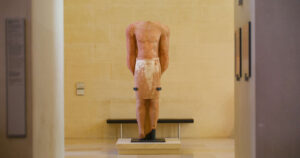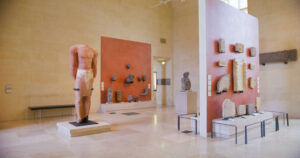
Paris, France 7th of September 2022: a magnificent 800 kilogram, 2.3-metre-tall statue of an ancient Lihyanite king unearthed by archaeologists working in the Dadan region of AlUla, Saudi Arabia, goes on display for the world to see at the Louvre Museum in Paris. As part of a far-reaching cultural collaboration and intergovernmental exchange partnership signed between Saudi Arabia and France, the Royal Commission for AlUla (RCU) is loaning the imposing sandstone statue to the iconic institution in the French capital from September for a period of five years.
AlUla is located in a fertile valley, at the ancient crossroads of the incense and aromatic caravan routes leading from the south of the Arabian Peninsula to Egypt, Mesopotamia and the shores of the Mediterranean. Around 2.800 years ago the ancient civilization of Dadan was located here. It was one of the most important trade route stations. Around the second half of the 1st millennium BCE, it was ruled by the kings of the Lihyan tribe, who retained power for several centuries.
Several colossal statues – believed to depict kings and priests – were discovered between 2005 and 2007 during archaeological excavations of the sanctuary of Dadan, led by King Saud University. One of these statues, called the ‘Monumental Statue’, which is now on loan at the Louvre, shows exceptional craftsmanship. The statue’s smooth surface with intricate details showing the muscles of the torso, abdomen, and the remains of the limbs displays characteristic elements of the Lihyanite school of sculpture. These features indicate the statue’s distinct local character and reflects the early artistic influence of Ancient Egypt or Greece.
The five-year loan is an important step to close a critical historical gap in the Louvre’s near-east collection, given that the Arabian Peninsula is under-represented in most of the Museum. This display highlights the archaeological discoveries and preservation work carried out at AlUla by the RCU. AlUla is home to 200,000 years of human history, and an important part of it can now be shared with the Louvre’s international audience through this long-term loan.
The statue was restored in France in 2010 in the context of the Roads of Arabia exhibition through a selection of 300 works, most of which had never been seen before outside their country of origin. Entitled “Archaeology and History of the Kingdom of Saudi Arabia,” the exhibition artifacts were presented at the Louvre at that time. During this exhibition visitors were offered an unprecedented glimpse into the various cultures that inhabited the territory of the Kingdom of Saudi Arabia from prehistoric times to the dawn of the modern era.
Since its establishment in 2017, RCU has overseen a wide range of archaeological projects, with finds of great importance to regional and global history made by an international team of experts. This exhibition is the beginning of what is hoped to be great collaborations between the RCU and major French institutions of heritage, research, and education.
____________________________

The Monumental Stature dates from the 5th – 3rd centuries BCE. Courtesy RCU
____________________________

The statue within its exhibit space. The statue is thought to depict a Lihyanite king. Courtesy RCU
____________________________
Article Source: Royal Commission for AlUla (RCU) news release.
____________________________
Advertisement





